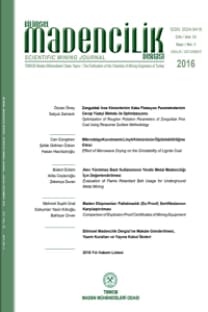An investigation on characterization and floation behavior of a transitional ore containing Galena and Pb Oxide minerals
serüzit, galen, kapalı devre, flotasyon, flaş
An investigation on characterization and floation behavior of a transitional ore containing Galena and Pb Oxide minerals
cerussite, galena, flotation, flash, locked cycle,
___
- Abkhoshk, E., Jorjani, E., Al-Harahsheh, M., Rashchi, F., Naazari, M. 2014. Review of the hydrometallurgical processing of non-sulfide zinc ores. Hydrometallurgy. 149, 153-167.
- Bulatovic, S. 2010. Handbook of Flotation Reagent Chemistry, Theory and Practice Volume 2: Flotation of Gold, PGM and Oxide Minerals. Elsevier.
- Elizondo-Álvarez, M. A., Uribe-Salas, A., Nava-Alonso, F. 2020. Flotation stud- ies of galena (PbS), cerussite (PbCO3) and anglesite (PbSO4 ) with hy- droxamic acids as collectors. Minerals Engineering. 155, 106456.
- Fa, K., Miller, J., Jiang, T., Li, G. 2005. Sulphidization flotation for recovery of lead and zinc from oxide-sulfide ores. Trans. Nonferrous Met. Soc. China. 15 (5), 1138-1144.
- Farrokhpay, S., Zanin, M. 2012. An investigation into the effect of water qual- ity on froth stability. Advanced Powder Technology. 23 (4), 493-497
- Feng, Q., Wen, S., Zhao, W., Wang, Y., Cui, C. 2015. Contribution of chloride ions to the sulfidization flotation of cerussite. Minerals Engineering. 83, 128-135.
- Feng, Q. C., Wen, S. M., Zhao, W. J., Cao, Q. B., Lü, C. 2016. A novel method for improving cerussite sulfidization. International Journal of Minerals, Metallurgy and Materials. 23 (6), 609-617.
- Fuerstenau, M. C., Olivas, S. A., Herrera-Urbina, R. Han, K. N., 1987. The sur- face characteristics and flotation behavior of anglesite and cerussite. International Journal of Mineral Processing. 20 (1-2), 73-85.
- Herrera-Urbina, R., Sotillo, F., Fuerstenau, D. 1998. Amyl Xanthate uptake by natural and sulfide-treated cerussite and galena. International Journal of Mineral Processing. 55 (2), 113-128.
- Herrera-Urbina, R., Sotillo, F. J., Fuerstenau, D. W. 1999. Effect of sodium sul- fide additions on the pulp potential and amyl xanthate flotation of ce- russite and galena. International Journal of Mineral Processing. 55(3), 157-170.
- Li, J., Liu, S., Liu, D., Liu, R., Liu, Z., Jia, X., Chang, T. 2020. Sulfidization mecha- nism in the flotation of cerussite: A heterogeneous solid-liquid reaction that yields PbCO3/PbS core-shell particles. Minerals Engineering. 153, 106400.
- Liu, C., Zhang, W., Song, S., Li, H., Jiao, X. 2019. A novel insight of the effect of sodium chloride on the sulfidization flotation of cerussite. Powder Technology. 344, 103-107.
- Liu, R., Liu, D., Li, J., Liu, S., Liu, Z., Gao, L., Jia, X., Ao, S. 2020. Improved under- standing of the sulfidization mechanism in cerussite flotation: An XPS, ToF-SIMS and FESEM investigation. Colloids and Surfaces A: Physico- chemical and Engineering Aspects. 124508.
- Marabini, A., Ciriachi, M., Plescia, P., Barbaro, M. 2007. Chelating reagents for flotation. Minerals Engineering. 20 (10), 1014-1025.
- Önal, G., Bulut, G., Gül, A., Kangal, O., Perek, K.T. Arslan, F., 2005. Flotation of Aladag oxide lead–zinc ores. Minerals Engineering. 18 (2), 279–282.
- Somasundaran, P., Lou, A. 1999. Oxide Mineral Flotation Fundementals, Ad- vances in Flotation Technology, ed. B. K. Parekh, & J. D. Miller, SME, s. 23-43.
- Thomas, W. 2010. Mining Chemicals Handbook. 2010 Edition, West Patter- son, NJ: Cytec Industries Inc.
- Wills, B., Napier-Munn, T. 2006. Wills’ Mineral Processing Technology: An Introduction to the Practical Aspects of Ore Treatment and Mineral Re- covery. 7th Edition. Butterworth-Heinemann, s. 278.
- ISSN: 2564-7024
- Yayın Aralığı: 4
- Yayıncı: TMMOB Maden Mühendisleri Odası
Yeni yaylı plaka kullanımı ile sürtünmeli kaya saplamaları performanslarının iyileştirilmesi
Mete Tayhan SERDENGEÇTİ, Bekir BAŞKURT, Kaan ÖZÇELİK, Hüseyin BAŞTÜRKCÜ
Düşük tenörlü barit cevherinin (Kozan/Adana) zenginleştirilmesinin araştırılması
Oktay BAYAT, Zehra ALTINÇELEP, Mahmut ALTINER
Kaya kütle makaslama dayanımının geri analiz yöntemi ile belirlenmesi: Bir vaka analizi
